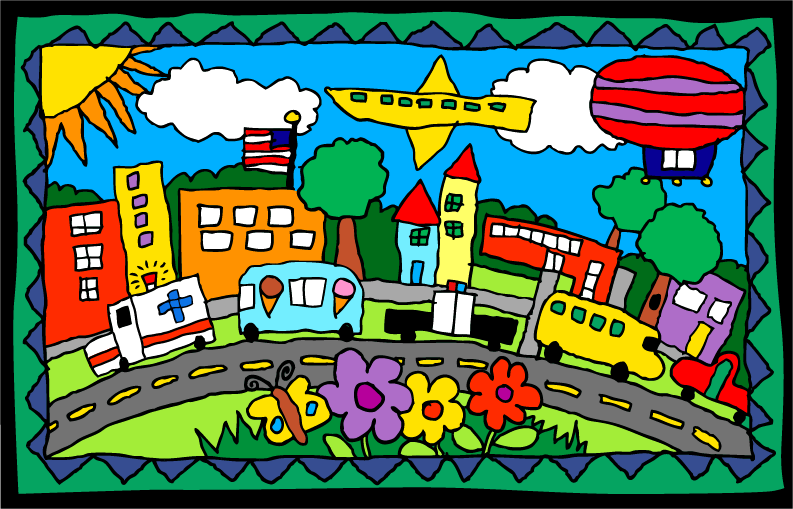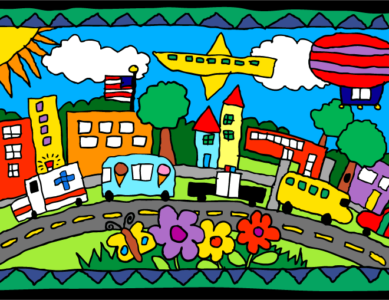The Role of Arts, Crafts, and Music In Education
The journey of school performance improvement gave me the most valuable education of my life. Some of the significant challenges faced by teachers were classroom management, student engagement and discipline, and behavior. They would say that children are not motivated to learn. Student attendance before and after the holidays fell dramatically. Teachers and Administrative Supervisors struggled until Miss Tammy Tusek introduced the school leadership to the fact that you cannot enter a child’s real world by force; it’s a trust-based privilege to which entry is By Invitation Only.
I understood this as a concept, but I had zero one-to-one experience on a personal level. The core focus of my life was work since the age of 26. I relocated to Jordan over a year ago and was hosted by my cousin Niveen for a couple of months until our household items arrived from Dubai. She has a 6-year-old boy Saif, and Celine, age 4.
Our home in Dubai was mostly very quiet. Even our three German Shepherds were so well trained that they only let out a couple of barks if someone was at the gate. My cousin’s home, by contrast, was bursting with the vibrant sounds of curious little children from morning till night, where most things represented a new experience. I greatly appreciated technology in the first couple weeks because their parents’ smartphones and tablets kept them occupied until I started paying close attention. I had developed a deep need to connect with them, but while they focused on the gadgets, they were closed off to the world around them. I was getting increasingly frustrated about not being able to reach them. Conversations with Saif remained superficial, where I got mono-syllabled responses, and he would generally ignore me if I asked him to do something. So I decided if the day would be about marathoning between Government departments to set up our Company, I should spend an hour at least in the evening with the kids.
The next day I bought with their grandfather, who was greatly amused by the choice, an assortment of colorful beads and string, and I asked Saif to work with me on making a bracelet for his grandmother. As I started teaching him, we started talking. We were having a real conversation for the first time. While he focused on inserting the string into the tiny holes in the beads without a needle, I told him he could only accomplish this with patience, focus, and perseverance. I started noticing signs of the early formation of his values from his reactions and words. He worked for so long that evening on the bracelet while I was holding the string from the other end, and when he only had one left, I accidentally dropped the string. He looked in shock as the beads bounced on the ground. I said: “I’m so sorry, Saif, please forgive me.” He calmly responded: “Don’t worry about it. It’s okay. We’ll do it again, don’t feel bad”.
To provide him with a visual reference of what focus and patience can achieve, I showed him the video of the Master Artist of micro-sculptures, Willard Wigan, and told him his story. I told him how his teacher treated him but without labeling the teacher’s behavior. He rewarded me with insight into another of his values; he recognized when someone was being mean and hurtful to another, and it showed on his face that he was upset and even slightly disgusted by the teacher’s treatment of Wigan as a little boy.
Saif made bracelets for his grandmothers and all his aunts, and with every new one, he got more creative. Because he was running short of beads of the same colors, he would tell his aunts that he would mix two colors. He would run to get his big bag of beads and string and ask them to choose which two colors they preferred. He had an appreciation that his aunts needed to select their preferred colors. His mom never takes off the bracelet he made her.
Once as I was reading him a story that featured ants, he asked me a question to which I responded he should look it up. He could work with one family member. I told him I would get him a present if he found the answer by the deadline. He asked his grandfather to help him, and the present was the type that I knew would allow me to spend even more time with him, a jigsaw puzzle. He was so excited that he wanted to start working on it immediately. His mom and I made our hot cocos and started helping him put it together. He expressed that Celine was getting on his nerves because she was messing up what we were completing. He told her annoyedly to stop playing with us. So I asked him to ask his little sis to help us because we could finish faster with collaboration. We asked her to put all the pieces of the same color on one side. I was pleased to see that she knew the names of the colors, she could recognize the different shades, and she looked for each color and handed it to us as we asked or set it aside along with the others of the same shade. The mission was accomplished an hour later.
Saif and I now enjoy a close relationship. We have discussions where he generously opens up and takes me further into his beautiful little world. I would have missed out on that opportunity had I focused only on my work, my needs, and especially the need for quiet.
But I was also surprised when Saif and I were going through a book about animals in the wild, and I said: “Saif imagine that…”. He said: “what do you mean imagine?” I said: “try to picture something in your head.” He said he didn’t understand. Then I realized it was something we needed to work on.
Imagination is the womb where creativity is conceived. I watched Netflix’s documentary yesterday called The Creative Brain. The Gathered Gallery Blog posted about it: “Michelle Khine, a scientist, working in nanotechnology research, explained, “To advance science, you have to be creative because otherwise, you’re just creating the same things that have already been created, and you’re thinking about things the same way everyone else has thought about it.” Dr. Michelle Khine drew upon the hours she spent playing with Shrinky Dinks in her childhood to solve a problem in her research on how chemical cues affect cell activity. The work earned Khine a spot on Technology Review’s 2009 TR35, an annual list of 35 innovators under 35 in business and technology worldwide. The documentary made me think of the unfocused arts, crafts, and music classes at some schools splattered across class schedules like an afterthought. Or how some parents in Jordan or the Middle East object to their kids taking music education at school.
Unfortunately, we are not yet fully aware of the benefits of how the development of interests and skills outside of numeracy and literacy related to sports, arts and crafts, dance, and music makes them happier children. USC posted that arts education “changes young lives” and “It creates an outlet for self-expression and opens doors to new cultures and ideas”. They note a study conducted by USC’s Brain and Creativity Institute (BCI) which revealed that instrument instruction appears to accelerate brain development. Neuroscientists compared schoolchildren learning to play musical instruments with peers who weren’t. They found that the young musicians had more-developed auditory pathways connecting the ear to the brain. The more-developed pathways could jumpstart a child’s abilities in areas beyond music, such as language and reading.
Some parents say: “enough of that nonsense and focus on your studies.” The history of humanity provides multiple examples of artists who actively explored mathematics in their artwork. Mathematics has itself been described as an art motivated by beauty.”
All of humanity is thankful that the great artists of the world since the beginning of time didn’t ask themselves, what’s the point?
Music and arts and crafts education develop children’s dexterity, teamwork, discipline, and self-confidence and provide an outlet for creativity and a constructive release of energy. Music and art also enable us to elevate into a different type of humans altogether where we no longer think about what makes us different from one another, but they join us in a bond of humanity.
This epic performance by Dr. L. Subramaniam, Jean Luc Ponty, and Billy Cobham is a clear example of that, where three magnificent musicians from different cultures take on the lives of those instruments, become those instruments, and sublimely merge into beauty itself, transcending all words in all the different languages of the world into the language of the immortals.



Thanks for your blog, nice to read. Do not stop.
I know this reply comes a little late, but I didn’t want to leave your kind words unacknowledged.
When I first published this, I didn’t expect it to reach anyone yet.
Thank you, Mark. I truly appreciate your encouragement.